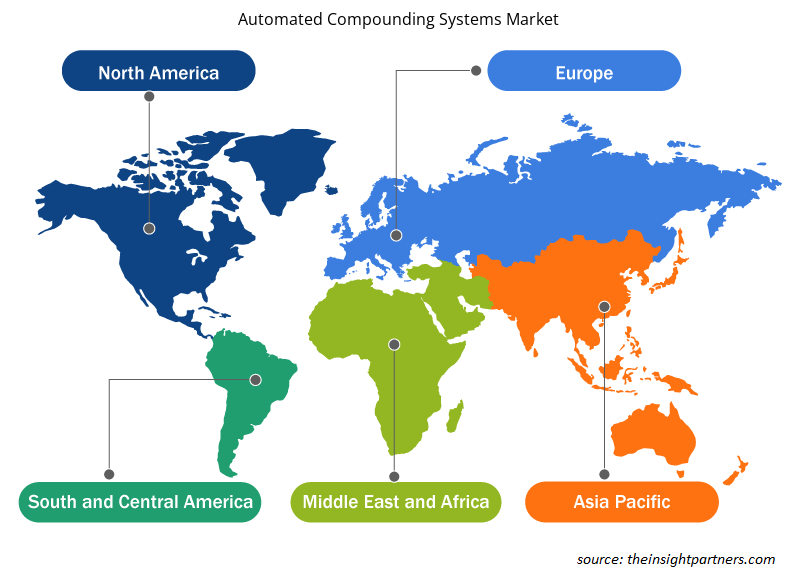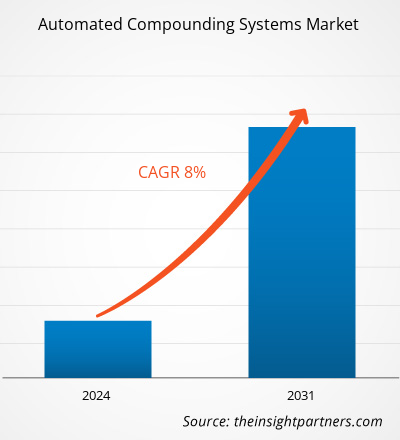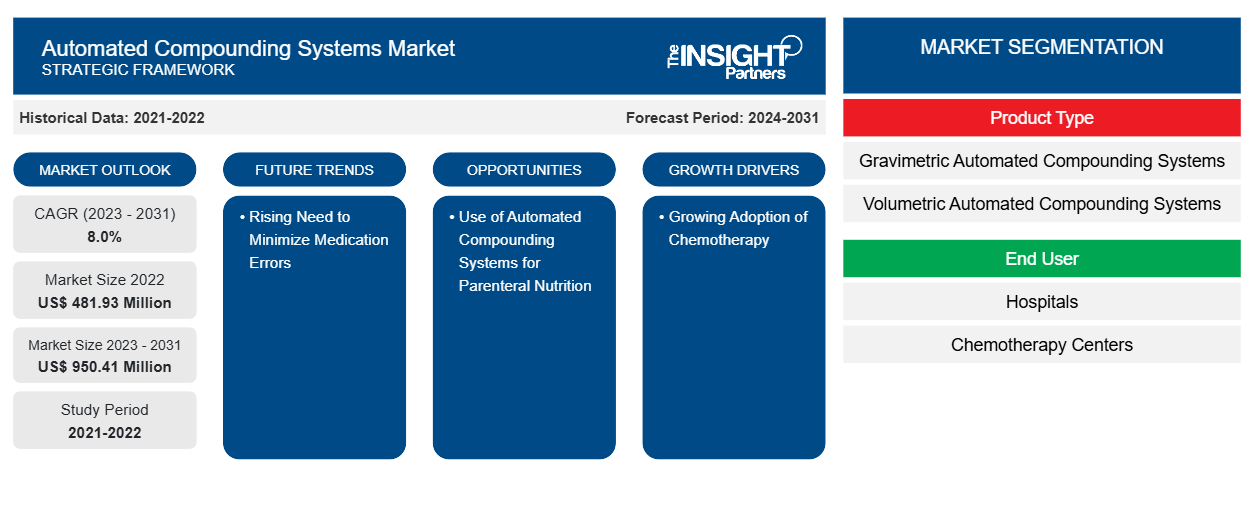Si stima che la dimensione del mercato dei sistemi di compounding automatizzati sia stata di 481,93 milioni di dollari USA nel 2022 e di XX milioni di dollari USA nel 2023 e si prevede che raggiungerà i 950,41 milioni di dollari USA entro il 2031; si stima che registrerà un CAGR dell'8,0% fino al 2031. È probabile che gli sviluppi strategici e i lanci di prodotti rimangano tendenze chiave del mercato dei sistemi di compounding automatizzati.CAGR of 8.0% till 2031. Strategic developments and product launches are likely to remain key Automated Compounding Systems Market trends.
Analisi di mercato dei sistemi di compounding automatizzati
La crescente domanda di medicinali personalizzati, la maggiore sicurezza dei pazienti, le severe normative per la preparazione dei farmaci, l'efficienza e l'economicità dei sistemi di preparazione automatizzati e la crescente consapevolezza dei farmacisti stanno guidando la crescita del mercato dei sistemi di preparazione automatizzati. Inoltre, l'aumento della prevalenza di malattie croniche ha alimentato la domanda di sistemi di preparazione automatizzati.
Panoramica del mercato dei sistemi di compounding automatizzati
Il sistema di preparazione automatizzata aiuta a evitare errori di medicazione che si verificano a causa di vari fattori, come la scarsa comunicazione gestionale tra medico e farmacista, pratiche di conservazione critiche nelle farmacie e confusione derivante dall'uso di etichette simili. Inoltre, con i sistemi di preparazione automatizzata, la precisione e l'efficienza della distribuzione di prodotti preparati sono migliorate e hanno ulteriormente ridotto l'esposizione degli operatori sanitari ad agenti tossici.
Personalizza questo report in base alle tue esigenze
Riceverai la personalizzazione gratuita di qualsiasi report, comprese parti di questo report, o analisi a livello nazionale, pacchetto dati Excel, oltre a usufruire di grandi offerte e sconti per start-up e università
-
Scopri le principali tendenze di mercato in questo rapporto.Questo campione GRATUITO includerà analisi di dati che spaziano dalle tendenze di mercato alle stime e alle previsioni.
Driver di mercato e opportunità dei sistemi di compounding automatizzati
Crescente necessità di ridurre al minimo gli errori di somministrazione dei farmaci
Errori di medicazione e distribuzione sono i principali problemi di riammissione ospedaliera in tutto il mondo. Errori di medicazione possono verificarsi sia da parte del personale medico che paramedico a vari livelli di assistenza ai pazienti. Un errore di medicazione può verificarsi a causa di diversi fattori, come scarsa comunicazione tra medico e farmacista, pratiche di stoccaggio pericolose nelle farmacie e incomprensioni dovute all'uso delle stesse etichette. Pertanto, il monitoraggio multilivello è obbligatorio. I sistemi di preparazione automatizzati sono considerati una delle soluzioni più qualificate per ridurre questi errori. Varie organizzazioni governative stanno lavorando sulle misure per evitare errori di medicazione e sviluppando metodi e sistemi per superare questi errori al fine di fornire farmaci adeguati ai pazienti. Pertanto, per ridurre al minimo gli errori di medicazione e preparazione, i governi di diverse nazioni stanno incoraggiando l'uso di strumenti di preparazione e medicazione automatizzati in farmacie e ospedali. Questo è considerato un fattore importante che spinge la crescita del mercato dei sistemi di preparazione automatizzati.readmissions across the world. Medication errors can happen by both medical and paramedical personnel at numerous levels of patient care. A medication error can happen due to several factors such as poor order communication between the doctor and pharmacist, hazardous storage practices in drugstores, and misunderstanding raised due to the usage of the same labels. Hence, multilevel monitoring is compulsory. Automated compounding systems are deliberated to be one of the most qualified solutions to diminish these errors. Various government organizations are working on the measures to avoid medication errors and developing methods and systems to overcome these errors in order to provide proper medication to the patients. Thus, to minimize medication and compounding errors, governments in several nations are encouraging the use of automated compounding and medication tools in pharmacies and hospitals. This is considered to be a major factor propelling the growth of automated compounding systems market.
Utilizzo di sistemi di preparazione automatizzati per la nutrizione parenterale: un'opportunità di mercato per i sistemi di preparazione automatizzatiParenteral Nutrition – An Opportunity of Automated Compounding Systems Market
La nutrizione parenterale è indicata quando i pazienti non riescono a soddisfare le proprie nutrition is indicated when patients cannot meet their esigenze nutrizionali a causa di malattie, come cancro e malattie croniche che colpiscono il tratto gastrointestinale. Questo tipo di nutrizione è la pietra angolare della terapia per la maggior parte dei pazienti con grave sindrome dell'intestino corto (SBS). La SBS si verifica in circa 3 persone su 1 milione all'anno. Secondo l'articolo intitolato "Understanding Short Bowel Syndrome: Current Status and Future Perspectives", pubblicato nel 2020, la prevalenza della SBS è aumentata di oltre il doppio negli ultimi 40 anni. La prevalenza era di circa 30 casi su milione negli Stati Uniti e di circa 1,4 casi su milione in Europa. I sistemi di preparazione automatizzati possono essere utilizzati per produrre prodotti di nutrizione parenterale. I sistemi di preparazione automatizzati sono solitamente collegati a un software dedicato che trasferisce elettronicamente informazioni sulle formulazioni PN. Numerosi ricercatori stanno confrontando le formulazioni PN preparate da sistemi di preparazione automatizzati e da metodi manuali. Si prevede che le ricerche in corso sull'uso di sistemi di preparazione automatizzati per la formulazione di PN creeranno opportunità di crescita del mercato dei sistemi di preparazione automatizzati.SBS). SBS occurs in ~3 per 1 million people yearly. As per the article titled “Understanding Short Bowel Syndrome: Current Status and Future Perspectives," published in 2020, the prevalence of SBS has increased by more than twofold in the last 40 years. The prevalence was ~30 cases per million in the US and approximately 1.4 cases per million in Europe. Automated compounding systems can be used to manufacture parenteral nutrition products. The automated compounding systems is usually linked to dedicated software that electronically transfers information about PN formulations. A number of researchers are comparing the PN formulations prepared by automated compounding systems and by manual methods. The ongoing researches for use of automated compounding systems for formulation of PN is expected to create opportunity for growth of automated compounding systems market.
Analisi della segmentazione del rapporto di mercato sui sistemi di compounding automatizzati
I segmenti chiave che hanno contribuito alla derivazione dell'analisi di mercato dei sistemi di preparazione automatizzata sono la via di somministrazione, l'applicazione e l'utente finale.
- In base al tipo di prodotto, il mercato dei sistemi di compounding automatizzati è segmentato in sistemi di compounding automatizzati gravimetrici e sistemi di compounding automatizzati volumetrici. Il segmento dei sistemi di compounding automatizzati gravimetrici ha detenuto la quota di mercato maggiore nel 2023.
- Per utente finale, il mercato dei sistemi di compounding automatizzati è segmentato in ospedali, centri di chemioterapia e altri. Il segmento degli ospedali ha detenuto la quota di mercato maggiore nel 2023.
Analisi della quota di mercato dei sistemi di compounding automatizzati per area geografica
L'ambito geografico del rapporto di mercato sui sistemi di miscelazione automatizzati è suddiviso principalmente in cinque regioni: Nord America, Asia Pacifico, Europa, Medio Oriente e Africa, Sud e Centro America.
Il Nord America ha dominato il mercato dei sistemi di compounding automatizzati. La crescita del mercato in Nord America è caratterizzata da una domanda crescente di farmaci per malattie croniche, dalla presenza di attori chiave del mercato, da un aumento dei lanci di prodotti, come la crescente adozione di sistemi di compounding automatizzati negli Stati Uniti, dalla crescente produzione farmaceutica, che sta portando alla domanda crescente di riempimento e confezionamento automatizzati di medicinali e da un'ampia R&S condotta da istituti accademici e di ricerca e aziende farmaceutiche. Inoltre, si prevede che l'Asia Pacifica registrerà il CAGR più elevato nei prossimi anni.
Approfondimenti regionali sul mercato dei sistemi di compounding automatizzati
Le tendenze regionali e i fattori che influenzano il mercato dei sistemi di compounding automatizzati durante il periodo di previsione sono stati ampiamente spiegati dagli analisti di Insight Partners. Questa sezione discute anche i segmenti e la geografia del mercato dei sistemi di compounding automatizzati in Nord America, Europa, Asia Pacifico, Medio Oriente e Africa e America centrale e meridionale.

- Ottieni i dati specifici regionali per il mercato dei sistemi di compounding automatizzati
Ambito del rapporto di mercato sui sistemi di compounding automatizzati
| Attributo del report | Dettagli |
|---|---|
| Dimensioni del mercato nel 2022 | 481,93 milioni di dollari USA |
| Dimensioni del mercato entro il 2031 | 950,41 milioni di dollari USA |
| CAGR globale (2023-2031) | 8,0% |
| Dati storici | 2021-2022 |
| Periodo di previsione | 2024-2031 |
| Segmenti coperti |
Per tipo di prodotto
|
| Regioni e Paesi coperti |
America del Nord
|
| Leader di mercato e profili aziendali chiave |
|
Sistemi di compounding automatizzati: densità degli attori del mercato: comprendere il suo impatto sulle dinamiche aziendali
Il mercato dei sistemi di compounding automatizzati sta crescendo rapidamente, spinto dalla crescente domanda degli utenti finali dovuta a fattori quali l'evoluzione delle preferenze dei consumatori, i progressi tecnologici e una maggiore consapevolezza dei vantaggi del prodotto. Con l'aumento della domanda, le aziende stanno ampliando le loro offerte, innovando per soddisfare le esigenze dei consumatori e capitalizzando sulle tendenze emergenti, il che alimenta ulteriormente la crescita del mercato.
La densità degli operatori di mercato si riferisce alla distribuzione di aziende o società che operano in un particolare mercato o settore. Indica quanti concorrenti (operatori di mercato) sono presenti in un dato spazio di mercato in relazione alle sue dimensioni o al valore di mercato totale.
Le principali aziende che operano nel mercato dei sistemi di compounding automatizzati sono:
- Semplicità
- Società controllata da Baxter International Inc.
- Braun Melsungen AG
- Commercio
- Terapia intensiva medica INC
- Grifols, SA
Disclaimer : le aziende elencate sopra non sono classificate secondo un ordine particolare.

- Ottieni una panoramica dei principali attori del mercato dei sistemi di compounding automatizzati
Notizie di mercato e sviluppi recenti sui sistemi di compounding automatizzati
Il mercato dei sistemi di compounding automatizzati viene valutato raccogliendo dati qualitativi e quantitativi dopo la ricerca primaria e secondaria, che include importanti pubblicazioni aziendali, dati associativi e database. Di seguito è riportato un elenco degli sviluppi nel mercato dei sistemi e delle strategie di compounding automatizzati:
- Simplivia ha lanciato l'innovativa soluzione di automazione chemio SmartCompounders potenziata dal principale Chemfort Closed System Drug-Transfer Device (CSTD). Fornisce a farmacisti e tecnici gli strumenti per rendere il processo di preparazione più breve e affidabile ed elimina gli errori nell'identificazione dei farmaci e nella quantità di dosaggio. (Fonte: Simplivia, sito Web aziendale, 2024)
- Baxter International Inc ha lanciato ExactaMix Pro Automated Compounder. ExactaMix Pro combina una sicurezza migliorata con funzionalità più intuitive ed efficienti e una maggiore potenza di elaborazione rispetto a ExactaMix. (Fonte: Baxter, sito Web aziendale, 2022)
Copertura e risultati del rapporto di mercato sui sistemi di compounding automatizzati
Il rapporto "Dimensioni e previsioni del mercato dei sistemi di compounding automatizzati (2021-2031)" fornisce un'analisi dettagliata del mercato che copre le seguenti aree:
- Dimensioni e previsioni del mercato a livello globale, regionale e nazionale per tutti i segmenti di mercato chiave coperti dall'ambito
- Dinamiche di mercato come fattori trainanti, vincoli e opportunità chiave
- Principali tendenze future
- Analisi dettagliata delle cinque forze PEST/Porter e SWOT
- Analisi di mercato globale e regionale che copre le principali tendenze di mercato, i principali attori, le normative e gli sviluppi recenti del mercato
- Analisi del panorama industriale e della concorrenza che copre la concentrazione del mercato, l'analisi della mappa di calore, i principali attori e gli sviluppi recenti
- Profili aziendali dettagliati
- Analisi storica (2 anni), anno base, previsione (7 anni) con CAGR
- Analisi PEST e SWOT
- Valore/volume delle dimensioni del mercato - Globale, Regionale, Nazionale
- Industria e panorama competitivo
- Set di dati Excel
Report recenti
Testimonianze
Motivo dell'acquisto
- Processo decisionale informato
- Comprensione delle dinamiche di mercato
- Analisi competitiva
- Analisi dei clienti
- Previsioni di mercato
- Mitigazione del rischio
- Pianificazione strategica
- Giustificazione degli investimenti
- Identificazione dei mercati emergenti
- Miglioramento delle strategie di marketing
- Aumento dell'efficienza operativa
- Allineamento alle tendenze normative























 Ottieni un campione gratuito per - Mercato dei sistemi di compounding automatizzati
Ottieni un campione gratuito per - Mercato dei sistemi di compounding automatizzati